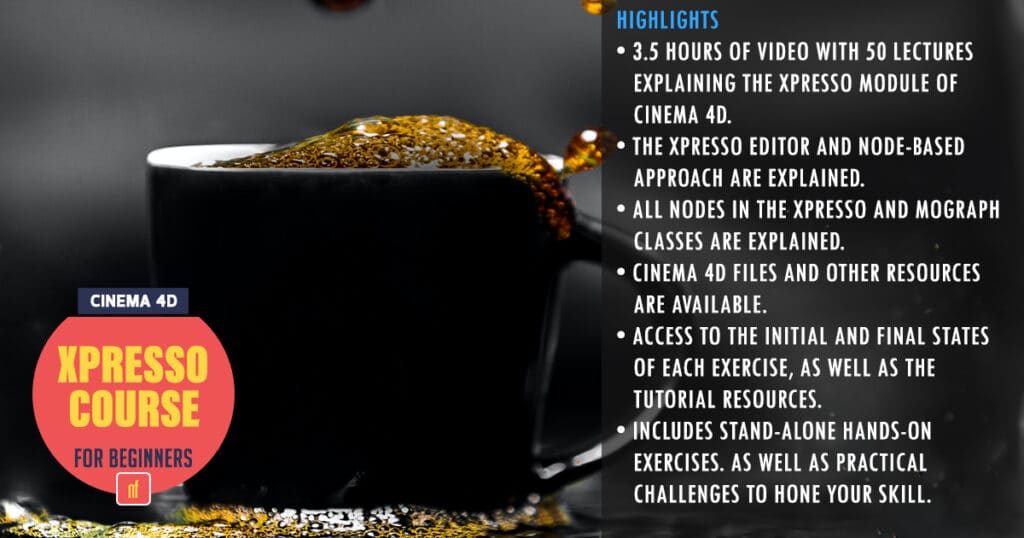CINEMA 4D XPresso Course: Become a Better CINEMA 4D Artist — Create XPresso networks in CINEMA 4D, automate your workflow, and expand your CINEMA 4D expertise

CINEMA 4D XPresso Course – What you’ll learn
In this course you will learn:
- About the node-based approach of XPresso Editor
- How to link properties and parameters
- How to create user-defined sliders
- How to create XPressions using the Driver/Driven feature
- How to use nodes of the MoGraph and XPresso classes
- How to automate tasks in CINEMA 4D
Description
The CINEMA 4D XPresso Course covers (Course Code: NFC001C4D01) the fundamentals of the XPresso module of CINEMA 4D which is a node-based visual scripting language. This course covers XPresso Editor and different nodes under the XPresso and MoGraph classes and takes you step-by-step through the whole process of building node networks in XPresso Editor. Numerous examples are used to show the functioning of the nodes.
As you move from one exercise to another exercise in this CINEMA 4D XPresso course, you will be gaining robust knowledge about the XPresso module of CINEMA 4D. The practical activities [under the “Practical Activities” section] included in this course allow you to experiment with what you have learned during the course.
Besides lifetime access to the course, you’ll also get access to all CINEMA 4D files, texture files, and any other resource used in the course. You are free to use these resources in your own projects personal or commercial. These working files allow you to follow along with the author throughout the lessons.
Note: If you want to follow along, you should have CINEMA 4D Studio R19 installed on your system. However, this course is also compatible with R16, R17, and R18 versions of CINEMA 4D.
The salient features of the CINEMA 4D XPresso course are as follows:
- 3.5 hours of on-demand video with 50 lectures explaining the XPresso module of CINEMA 4D.
- XPresso Editor and node-based approach explained.
- All nodes of the XPresso and MoGraph classes explained.
- CINEMA 4D files and other resources are available.
- Access to each exercise’s initial and final states along with the resources used in the tutorial.
- Includes stand-alone hands-on exercises.and practical challenges to hone your skills.
- Tech support direct from the author.
So why wait?
Enroll in the course and become an expert XPresso visual language programmer.
What are the prerequisites
- Before you start this course, you should have CINEMA 4D Studio R19 installed on your system. However, this course is also compatible with R16, R17, and R18 versions.
- You should also have a basic knowledge of CINEMA 4D.
- You should have a desire to learn.
- Willingness to be awesome.
Who are the ideal students for CINEMA 4D XPresso Course
- Beginners and intermediate users of CINEMA 4D
- Digital artists
- Motion graphics artists
- Indie game developers
- And anyone who wants to learn CINEMA 4D
Curriculum
Section 1: Introduction
- What you will be creating?
- Read before proceeding farther
- Vectors, Matrix, and Normals
Section 2: Node Reference Library- Cinema 4D XPresso Class
- How to read color values at specific coordinates using the Bitmap node?
- How to access dimensions of an object using the Bounding Box node?
- How to convert kelvin temperatures to RGB using the Color Temperature node?
- How to detect collision between two polygonal objects using the Collision node?
- How to freeze attributes’ values using the Freeze Node?
- How to create delay effects using the Memory node?
- How to trigger an event using the MonoFlop Node?
- How to access information about an object’s points using the Point node?
- How to randomize the attributes of an object using the Noise node?
- How to represent an object in XPresso Editor using the Object node?
- How to find the index number in object array using the Object Index node?
- How find no polygons and their positions in an object using the Polygon Node?
- How to generate a random number in -1 to 1 range using the Random node?
- How to detect collision between two poly objects using the Ray Collision node?
- How to navigate in an object hierarchy using the Reference node?
- How to load and playback sound in the viewport using the Sound node?
- How to use the Spy Node for troubleshooting?
- How to read an FCurvre value using the Track node?
- How to convert a matrix to four-vector components using the Matrix2vectors node?
- How to convert real values to a single vector using the Reals2Vector node?
- How to convert one data type to another using the Universal node?
- How to split a vector to real values using the Vector2Reals node?
- How to convert four vectors to a matrix using the Vector2Matrix node?
- How to convert colors from one colorspace to another using the Colorspace node?
- How to use math and trigonometric functions using the Formula node?
- How to mix and blend two values using the Mix node?
- How to remap values from one range to another using the Range Mapper node?
- How to output numbers of objects in a hierarchy path using the Hierarchy node?
- Know about other nodes available in the XPresso class.
Section 3: Node Reference Library- MoGraph Class
- How to read relevant data of the clone generating objects using the Data node?
- How to use the Falloff node to access MoGraph’s falloff feature?
- Know about other nodes available in the MoGraph class
Section 4: Tutorials
- Creating a Clock Rig
- Animating a Table Fan
- Creating Bouncing Ball Animation
- Creating a Digital Counter
- Working with Set Driven Keys
- Generating a Random Integer Number Within a Specific Range
- Calculating Angle Between Two Input Vectors
- Calculating the Normal Vector
Section 5: Practical Challenges
- Challenges
Section 6: Appendix: XPresso Editor
- Working with XPresso Editor
- XPresso Editor Menu and Contextual Menu Commands
Enroll in the CINEMA 4D XPresso Course
If you have any questions about this course, contact us. Click here to check out more courses.
#cinema4d #cinema4dxpresso #neuronsfactory

